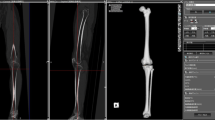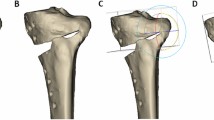Abstract
Opening wedge high tibial osteotomy (OWHTO) is widely used to treat unicompartmental osteoarthritis of the knee caused by degenerative deformations of the anatomical axes of the leg. However, since it is difficult to accurately plan the surgical adjustment degrees such as coronal correction angle and tibial posterior slope angle in order to align the axes before the actual procedure, a number of studies have proposed analytical models to solve this problem. While previous analytical models for OWHTO were limited to specific tibial configurations, this study proposes a Generic analytical osteotomy model (GAOM) and a surgical planning system that are applicable for general tibial morphologies and tibia conditions. The validity and generality of the model were verified in a total of 60 OWHTO cases. Results showed that the tibial shape and the slope of the cut plane significantly affect the adjustment degrees. Comparison between the required degrees and the ones estimated from GAOM resulted in the mean error of 0.12°. The surgical planning system, based on GAOM, allows the operating surgeon to easily calculate surgical parameters needed to treat a patient.
Similar content being viewed by others
References
J. N. Insall, D. Joseph and C. Msika, High tibial osteotomy for varus gonarthrosis, J. Bone Joint Surg Am, 66 (1984) 1040–1048.
A. Amendola and L. Panarella, High tibial osteotomy for the treatment of unicompartmental arthritis of the knee, Orthopedic Clinics of North America, 36 (4) (2005) 497–504.
R. Ellis, C. Tso, J. Rudan and M. Harrison, A A surgical planning and guidance system for high tibial osteotomy, Computer Aided Surgery, 4 (5) (1999) 264–274.
E. K. Song, High tibial osteotomy for osteoarthritis of the knee, J. of Korean Orthop Assoc., 39 (2004) 104–107.
E. K. Song, J. K. Seon, S. J. Park and N. Y. Cho, Open wedge high tibial osteotomy with aescular plate, J. of Korean Orthop Assoc., 43 (2004) 391–395.
D. J. Chae, G. M. Shetty, D. B. Lee, H. W. Choi, S. B. Han, and K. W. Nha, Tibial slope and patellar height after opening wedge high tibia osteotomy using autologous tricortical iliac bone graft, The Knee, 15 (2) (2008) 128–133.
D. Kendoff, D. Lo, P. Goleski, B. Warkentine, P. O’Loughlin and A. Pearle, A Open wedge tibial osteotomies influence on axial rotation and tibial slope, Knee Surgery, Sports Traumatology, Arthroscopy, 16 (10) (2008) 904–910.
M. Ozalay et al., A The correlation of correction magnitude and tibial slope changes following open wedge high tibial osteotomy, Knee Surgery, Sports Traumatology, Arthroscopy, 16 (10) (2008) 948–951.
J. R. Giffin, T. M. Vogrin, T. Zantop, S. L. Woo and C. D. Harner, Effects of increasing tibial slope on the biomechanics of the knee, The American Journal of Sports Medicine, 32 (2) (2004) 376–382.
S. Aydoğdu, B. Alparslan and H. Sur, A Tibial slope changes following dome-type high tibial osteotomy, Knee Surgery, Sports Traumatology, Arthroscopy, 13 (1) (2005) 38–43.
J. H. Wang, J. H. Bae, H. C. Lim, W. Y. Shon, C. W. Kim and J. W. Cho, Medial open wedge high tibial osteotomy the effect of the cortical hinge on posterior tibial slope, The American Journal of Sports Medicine, 37 (12) (2009) 2411–2418.
E. Hohmann and A. Bryant, Closing or opening wedge high tibial osteotomy: watch out for the slope, Operative Techniques in Orthopedics, 17 (1) (2007) 38–45.
F. R. Noyes, W. Mayfield, S. D. Barber-Westin, J. C. Albright and T. P. Heckmann, Opening wedge high tibial osteotomy an operative technique and rehabilitation program to decrease complications and promote early union and function, The American Journal of Sports Medicine, 34 (8) (2006) 1262–1273.
P. Hernigou, H. Ovadia and D. Goutallier, Mathematical modelling of open-wedge tibial osteotomy and correction tables, Revue de Chirurgie Orthopedique et Reparatrice de L'appareil moteur, 78 (4) (1991) 258–263.
T. Koshino, T. Murase and T. Saito, Medial openingwedge high tibial osteotomy with use of porous hydroxyapatite to treat medial compartment osteoarthritis of the knee, The Journal of Bone & Joint Surgery, 85 (1) (2003) 78–85.
F. R. Noyes, S. X. Goebel and J. West, Opening wedge tibial osteotomy the 3-triangle method to correct axial alignment and tibial slope, The American Journal of Sports Medicine, 33 (3) (2005) 378–387.
Y. S. Lee, S. J. Park, V. I. Shin, J. H. Lee, Y. H. Kim and E. K. Song, Achievement of targeted posterior slope in the medial opening wedge high tibial osteotomy: a mathematical approach, Annals of Biomedical Engineering, 38 (3) (2010) 583–593.
G. Murray, Rotation about an arbitrary axis in 3 dimensions, Retrieved September, 21 (2005) 2006.
A. R. Zorzi, H. G. da Silva, C. Muszkat, L. C. Marques, A. Cliquet Jr. and J. B. de Miranda, Opening-wedge high tibial osteotomy with and without bone graft, Artificial Organs, 35 (3) (2011) 301–307.
W. Kolb, H. Guhlmann, C. Windisch, K. Kolb, H. Koller and P. Grützner, Opening-wedge high tibial osteotomy with a locked low-profile plate, The Journal of Bone & Joint Surgery, 91 (11) (2009) 2581–2588.
E. W. Weisstein, Rodrigues’ rotation formula. From MathWorld–A Wolfram Web Resource, http://mathworld.wolfram.com/RodriguesRotationFormula.html (2006).
J.-W. Lee, Y.-Z. Xin, J.-H. Ji, K. Panchal, O.-S. Kwon and S.-J. Yang, Stress analysis of the tibial plateau according to the difference of blade path entry in opening wedge high tibial osteotomy, Journal of Mechanical Science and Technology, 29 (3) (2015) 1175–1179.
Author information
Authors and Affiliations
Corresponding author
Additional information
Recommended by Associate Editor Moon Ki Kim
Jay J. Kim is a Full Professor of the school of Mechanical Engineering at the Hanyang University, where he teaches Computer-Aided Geometric Modeling and Computer-Aided Design. He received his B.S. (1981) in Mechanical Engineering from the Hanyang University and M.S. (1983) in Mechanical Engineering from the George Washington University and Ph.D. (1989) in Mechanical Engineering from the Massachusetts Institute of Technology. His research interests include geometric modeling in computer-aided design and manufacturing, product lifecycle management and biomedical engineering, as well as applications of commercial CAD systems.
Eun-Joo Park is currently a Ph.D. student in the Department of Mechanical Engineering at the Hanyang University. She received the B.S. degree in Mechanical Engineering from the Hanyang University in 2013. Currently, her research interests focus on biomechanics, computer graphics and software engineering.
Rights and permissions
About this article
Cite this article
Choi, DK., Koo, BY., Park, BK. et al. Generic analytical osteotomy model for three-dimensional surgical planning in opening wedge high tibial osteotomy. J Mech Sci Technol 30, 3877–3885 (2016). https://doi.org/10.1007/s12206-016-0753-x
Received:
Revised:
Accepted:
Published:
Issue Date:
DOI: https://doi.org/10.1007/s12206-016-0753-x




